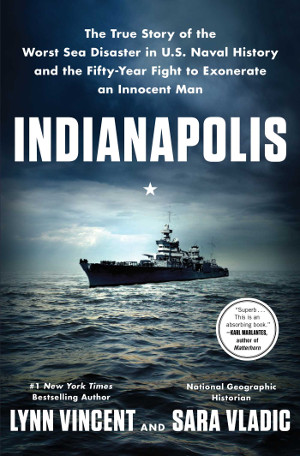Featured Book
Reviewed by Bob Hackett


"INDIANAPOLIS: The True Story of the Worst Sea Disaster in U.S. Naval History and the Fifty-Year Fight to Exonerate an Innocent Man."
by Lynn Vincent and Sara Vladic
Hardbound with dust cover, 544 pages,
Published by Simon & Schuster, MSLP $28,
ISBN: 978-1-5011-3594-1,
July 2018
A trip to the beach has never been quite the same since 1975 when fictional fishing boat Captain and shark hunter “Quint” (late Robert Shaw) introduced oceanographer “Matt Hooper” (Richard Dreyfuss) and the World to man-eating sharks in Steven Spielberg’s thriller film “Jaws” based on Peter Benchley's 1974 novel. Some 300 men go down with torpedoed heavy cruiser USS INDIANAPOLIS. Quint retells how about 880 survivors went in the water for four horrific days, but only 316 men came to be rescued. The rest died from thirst, dehydration, drowning or were eaten by sharks mainly because the ship had slipped off the Navy’s tracking system. “Jaws” was the first time many Americans heard about INDIANAPOLIS.
The authors are Lynn Vincent, a Navy veteran, NY Times bestselling author and coauthor of eleven nonfiction books and an investigative journalist, and Sara Vladic, a documentary filmmaker, National Geographic historian and one of the world’s leading experts on the USS INDIANAPOLIS.
Launched in 1932, INDIANAPOLIS served as President Franklin Roosevelt's ship of state. After the disaster at Pearl Harbor, INDIANAPOLIS lead the charge back into the Pacific. From her bridge, Admiral Raymond Spruance helped devise and execute the campaign that decimated Imperial Japan. On 31 March 1945, off Okinawa, a Japanese kamikaze suicide plane and bomb punched through the 5th Fleet's flagship INDIANAPOLIS' thin-skinned decks to her bottom and exploded in the sea. Badly damaged, INDY had to return to Mare Island, CA for repairs. Patched up, she departed CA on 16 July, in a top-secret mission carrying components of the "Little Boy" atomic bomb. On July 26, she arrived at Tinian, Marianas Islands and delivered the "package" for the 509th Composite Group's B-29 bombers use on Hiroshima.
At 0910, 28 July, Captain Charles B. McVay, III's USS INDIANAPOLIS (CA-35), denied escorts because of the heavy destroyer and destroyer escort losses off Okinawa, departed Guam for Leyte, Philippines, sailing alone and not equipped with sonar or hydrophones to detect submarines. On 30 July 1945, just after midnight, in the center of the Philippine Sea, INDIANAPOLIS was struck and sunk by two big Japanese Type 95 torpedoes fired by one of the few Japanese submarines still operational, LtCdr Mochitsura Hashimoto's I-58 - just 16 days from the end of hostilities in the Pacific.
The authors provide a visceral account of the disaster that followed after the INDY was torpedoed, from the chaos on board the sinking ship to the shock as the crew plunged into the waters of the Philippine Sea, to the long days and nights during which terror and hunger morphed into delusion and desperation, and the men banded together to survive.
In August 1945, Pacific Fleet Commander, Admiral Chester Nimitz ordered a court of inquiry to investigate INDY's sinking. CNO Fleet Admiral Ernest J. King
was unhappy with the court's inquiry. He felt too few witness were called, too little evidence uncovered and too many questions were left unanswered. He overruled Nimitz and asked Secretary of the Navy James Forrestal to order Captain McVay tried by court-martial. Despite testimony by I-58's LtCdr Hashimoto that refuted the Navy's chief accusation that McVay's "failure to zigzag" caused the loss of the ship. Captain (later Vice Admiral) Glynn Donaho, a sub CO and expert, concurred that zigzagging was of little value. Nevertheless, in December 1945, the Navy court found McVay guilty - the only Navy captain court-martialed for losing a ship during the war. That same month, King retired and was replaced by Nimitz as CNO.
Nimitz never agreed with King that McVay should be court-martialed and recommended that Forrestal set aside McVay's sentence, which he did. McVay, whose life and career were never the same after the scandal, continued to serve until June 1949 when he was retired with a "tombstone" promotion to Rear Admiral. McVay committed suicide in 1968.
Over a period of 10 years, the authors interviewed 107 survivors and eyewitnesses and conducted independent research until they were able to tell the definitive account of the INDIANAPOLIS and her crew. Many of McVay’s surviving crewmen believed the military had made him a scapegoat.
This outstanding 554-page book reflects the thoroughness and years it took to prepare. It contains a prologue, 5 "books" (chapters) with endnotes, a final log entry describing the discovery of the wreck of INDIANAPOLIS deep in the Phillipine Sea and a final sailing list, illustrations, maps, charts and 57 rare photographs, two appendices, an interesting methodology, bibliography, acknowledgements and an index.
Vincent and Vladic's book provides a convincing analysis, a gripping narrative and a pitiless exposure of institutional disingenuousness. The authors expose the Navy’s diligent efforts to discover what went wrong - but when it did, to shield the admirals responsible from consequences. A subsequent investigation led to McVay’s exoneration. In 2000, 55 years after INDIANAPOLIS went down, Congress cleared his name.
I highly recommend this book, available everywhere on 10 July 2018. - For further info please see I-58
- Bob Hackett




